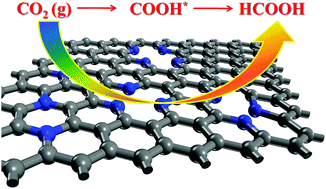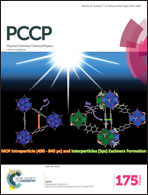Pyrrolic-nitrogen doped graphene: a metal-free electrocatalyst with high efficiency and selectivity for the reduction of carbon dioxide to formic acid: a computational study†
Abstract
Searching for metal-free catalysts for the carbon dioxide reduction reaction (CO2RR) has been a key challenge in the electrosynthesis of fuels for CO2 utilization. In this work, we investigated the potential of N-doped graphene as the electrocatalyst of CO2RR by means of comprehensive density functional theory (DFT) computations. The computations revealed that N-doping can modify the electronic properties of graphene for enhancing the electrochemical reduction of CO2 into CO and HCOOH, resulting in a low free energy barrier for the potential-limiting step to form the key intermediate COOH as well as the strong adsorption energy of adsorbed COOH and the weak adsorption energy of CO or HCOOH. The highest catalytic activity toward CO2RR is shown by pyrrolic N-doped graphene due to its lowest overpotential of 0.24 V among all N-doped graphenes, and leads exclusively to HCOOH as the product. Therefore, our results demonstrated that N-doped graphene holds great promise as an electrocatalyst for the CO2RR with high efficiency and selectivity by suitably tuning its N species.

- This article is part of the themed collection: 2016 most accessed PCCP articles

 Please wait while we load your content...
Please wait while we load your content...